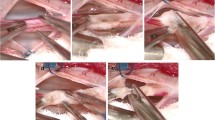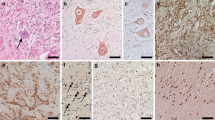Abstract
Purpose
Tethered cord syndrome (TCS) is an important disease and can produce progressive neurological symptoms. Studies about the filum terminale (FT) have drawn attention to the importance of histopathological investigation of this structure. The most interesting of these subtypes is the FT that incorporates peripheral nerve fibers (PNF). Our study aimed to analyze the frequency of PNF in the FT of 40 cases diagnosed with TCS.
Methods
We performed a retrospective histopathological investigation of FT excised during surgery of patients with TCS who underwent de-tethering. Neurologic and other types of postoperative complications were also revised.
Results
Analysis of the samples showed six dominant histopathological subtypes in the FT: fibroadipose tissues including peripheral nerve bundles (n = 14, 37 %), fibroadipose tissue (n = 10, 25 %), fibrous or adipose tissue (n = 7, 17 %), glial tissues including peripheral nerve sections (n = 4, 10 %), and ependymal and glial tissues (n = 4, 10 %). None of the patients presented with neurologic postoperative complications.
Conclusion
Embryologic studies revealed that it is common to encounter different histological subtypes of FT pathology. However, the presence of peripheral nerve cells in the FT is important for neurosurgical practice due to the risk of sectioning a functional structure during surgery. In our analysis, we demonstrated the high frequency of PNF in FT pathology. However, since none of the patients showed any symptoms of neurologic deterioration, we considered that these fibers were probably not functional. Our findings emphasize the importance of neuromonitoring in TCS surgery. Although we consider that most of the fibers are probably not functional, neuromonitoring after surgery may prevent serious complications.




Similar content being viewed by others
References
Hertzler DA 2nd, DePowell JJ, Stevenson CB, Mangano FT (2010) Tethered cord syndrome: a review of the literature from embryology to adult presentation. Neurosurg Focus 29(1):E1
Lew SM, Kothbauer KF (2007) Tethered cord syndrome: an updated review. Pediatr Neurosurg 43(3):236–248
Bui CJ, Tubbs RS, Oakes WJ (2007) Tethered cord syndrome in children: a review. Neurosurg Focus 23(2):E2
George TM, Fagan LHJ (2005) Adult tethered cord syndrome in patients with postrepair myelomeningocele: an evidence-based outcome study. Neurosurgery 102(2 Suppl):150–156
Selden NR (2007) Minimal tethered cord syndrome: what’s necessary to justify a new surgical indication? Neurosurg Focus 23(2):E1
Selden NR (2006) Occult tethered cord syndrome: the case for surgery. J Neurosurg 104(5 Suppl):302–304
Selden NR, Nixon RR, Skoog SR, Lashley DB (2006) Minimal tethered cord syndrome associated with thickening of the terminal filum. J Neurosurg 3(Suppl):214–218
Steinbok P, MacNeily AE (2007) Section of the terminal filum for occult tethered cord syndrome: toward a scientific answer. Neurosurg Focus 23(2):E5
Warder DE (2001) Tethered cord syndrome and occult spinal dysraphism. Neurosurg Focus 10(1):e1
Cardoso M, Keating RF (2009) Neurosurgical management of spinal dysraphism and neurogenic scoliosis. Spine (Phila Pa 1976) 34(17):1775–1782
Yamada S, Won DJ, Pezeshkpour G, Yamada BS, Yamada SM, Siddiqi J, Zouros A, Colohan AR (2007) Pathophysiology of tethered cord syndrome and similar complex disorders. Neurosurg Focus 23(2):E6
Pinto FC, Fontes RB, Leonhardt Mde C, Amodio DT, Porro FF, Machado J (2002) Anatomic study of the filum terminale and its correlations with the tethered cord syndrome. Neurosurgery 51(3):725–729, discussion 729–730
Selçuki M, Unlü A, Uğur HC, Soygür T, Arikan N, Selçuki D (2000) Patients with urinary incontinence often benefit from surgical detethering of tight filum terminale. Childs Nerv Syst 16(3):150–154, discussion 155
Selçuki M, Vatansever S, Inan S, Erdemli E, Bağdatoğlu C, Polat A (2003) Is a filum terminale with a normal appearance really normal? Childs Nerv Syst 19(1):3–10
Liu FY, Li JF, Guan X, Luo XF, Wang ZL, Dang QH (2011) SEM study on filum terminale with tethered cord syndrome. Childs Nerv Syst 27(12):2141–2144
Miklos R, Erika L, Csaba B (2004) The caudal end of the rat spinal cord: transformation to and ultrastructure of the filum terminale. Brain Res 1028:133–139
Izci Y, Pusat S, Onguru O (2011) Fatty filum with different histological features. Case report. Neurocirugia (Astur) 22(5):457–460
Tehli O, Hodaj I, Kural C, Solmaz I, Onguru O, Izci Y (2011) A comparative study of histopathological analysis of filum terminale in patients with tethered cord syndrome and in normal human fetuses. Pediatr Neurosurg 47(6):412–416
Fontes RB, Saad F, Soares MS, de Oliveira F, Pinto FC, Liberti EA (2006) Ultrastructural study of the filum terminale and its elastic fibers. Neurosurgery 58(5):978–984, discussion 978–984
Gaddam SS, Santhi V, Babu S, Chacko G, Baddukonda RA, Rajshekhar V (2012) Gross and microscopic study of the filum terminale: does the filum contain functional neural elements? J Neurosurg Pediatr 9(1):86–92
Lindsay KW, Teasdale GM (1980) Electrophysiological identification of nerve roots during operations for spinal dysraphism. Surg Neurol 14:49–51
Legatt AD, Schroeder CE, Gill B, Goodrich JT (1992) Electrical stimulation and multichannel EMG recording for identification of functional neural tissue during cauda equina surgery. Childs Nerv Syst 8:185–189
Phillips LH II, Jane JA (1996) Electrophysiologic monitoring during tethered spinal cord release. Clin Neurosurg 43:163–174
Phillips LH II, Park TS (1990) Electrophysiological monitoring during lipomyelomeningocele resection. Muscle Nerv 13:127–132
Quiñones-Hinojosa A, Gadkary CA, Gulati M, von Koch CS, Lyon R, Weinstein PR et al (2004) Neurophysiological monitoring for safe surgical tethered cord syndrome release in adults. Surg Neurol 62:127–135
von Koch CS, Quiñones-Hinojosa A, Gulati M, Lyon R, Peacock WJ, Yingling CD (2002) Clinical outcome in children undergoing tethered cord release utilizing intraoperative neurophysiological monitoring. Pediatr Neurosurg 37:81–86
Author information
Authors and Affiliations
Corresponding author
Rights and permissions
About this article
Cite this article
Durdağ, E., Börcek, P.B., Öcal, Ö. et al. Pathological evaluation of the filum terminale tissue after surgical excision. Childs Nerv Syst 31, 759–763 (2015). https://doi.org/10.1007/s00381-015-2627-4
Received:
Accepted:
Published:
Issue Date:
DOI: https://doi.org/10.1007/s00381-015-2627-4




